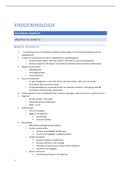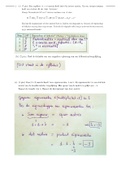STRATEGIC MANAGEMENT
PART 1: STRATEGY DISCOVERED
CHAPTER 1: STRATEGY DEFINED
- Success in business has 2 fathers:
o Strategy ~ art of the general in the army
▪ Strategy maps & action plans
▪ Better understanding of why things need to be done
o Luck
- 2 different kinds of businesspeople:
o One with a good strategy, but he doesn’t communicate
o One without a strategy written out, but he communicates
o The second one is the best
▪ Not being able to make choices often results in mediocrity and underper-
formance
▪ + every company eventually has a strategy
THE STEINBERG STORY
He set up stores. One of his stores was suffering from losses -> closed on Friday, installed self-
service formula, lowered prices by 25%, chanced name, made brochure and distributed -> reo-
pening on Monday
➔ Strategic change!
only possible for smaller companies for this short period of time
STRATEGIC FORMULATION: AN ENSEMBLE OF HARD AND SOFT INFORMATION
- Hard information
o Mostly quantified
o Much more reliable than soft information
o Examples:
▪ Data about sales
▪ Information from market research
o Only consider the past as a source of knowledge to make better choices for the
future
often comes too late
lacks nuances and details
most of this data is about the past
- Soft information
o Coming from gossip, impressions or info from conversations
o Most of the time managers base their decisions upon oral communication
speculative
depends upon the memory of people
Sarah Lootens Strategic Management
Chapter 1: strategy defined 1
, not accurate > depends on the memory of people
MINTZBERG’S VISION ON STRATEGY
- Intended strategy: you start with a plan,
but only part of the plan you made to-
day, will have been realised 3-5 years
from now
o 2 reasons:
▪ Unrealised strategy
▪ Opportunistic strategy
- Unrealised strategy: part of your intended strategy of which you decide not to do it
not something I was not able to do! -> false
o Example: meeting a guy who sells products in Czech Republic
▪ There’s a problem: Czech R unreliable -> not entering that market
▪ It was a plan, but wasn’t realised
- Opportunistic strategy: opportunities, strategies might pop up; wasn’t foreseen
o Example: opportunity to go to Portugal: it arises along the way
o The fallacy of prediction – the future is unknown
o The fallacy of detachment – impossible to divorce information from implementa-
tion
o The fallacy of formulization – formulization inhibits flexibility, spontaneity, intui-
tion and learning
A DEFINITION OF STRATEGIC MANAGEMENT
- Definition consists of three components
o Meaningful positioning within an environment of a company, a product or a brand
▪ Positioning: giving your company a position among your competitors
▪ Environment is important: without a good understanding of the business
environment, positioning becomes an empty concept
▪ Meaningful: long-term goals
• Continuity goals -> survival of the company
o Turnover, market share, profitability
• Social goals -> relationships within the organisation
o Well-being of the people working in the company
• Societal goals -> relationships between your organisation and the
broader external world
o Taking care of environment -> boost corporate image &
sales
o Within a well-defined time span
▪ Deadlines
▪ Short-term objectives
o Different ways are possible
▪ Different strategies are possible to get the same results
▪ Example: Colruyt & Delhaize: 2 different strategies but both successful
Sarah Lootens Strategic Management
Chapter 1: strategy defined 2
, - Goal: these components make it possible to realise a sustainable competitive advantage
o Sustainable: need to build up a competitive advantage that will last over time
o Example: profit of 10% -> not sustainable -> competition would follow
THE STRATEGIC TRIANGLE
- Different elements
o Steering elements (want): things that give
direction in your company
▪ Business definition, sort- or long-term
goals or the strategies
o Resources (can): resources you have
▪ Money, capital, human resources,
knowledge…
▪ Solid resource base will help you in the
realisation of your goals
o Environment (should): external world + linked to opportunities and threats
- Key thing: finding good balance between the elements -> competitive advantage
- The more tension between the elements -> harder to build up or sustain a competitive
advantage
o Example: company wants to double its sales but is confronted with changing mar-
ket needs -> tension between ambitions & environment
CHAPTER 2: STRATEGIC DECISION-MAKING
THE DIFFERENCE BETWEEN ENTREPRENEURS AND MANAGERS IN DEALING WITH
STRATEGY
- Causal thinkers (managers):
o Start with an End in mind
o Try to find the best Means to achieve it
o Causality: assumes the future is theoretically predictable based on prior events
- Effectual thinkers (entrepreneurs):
o Start with a given set of Means
o Find new and different Ends
o Effectuation: z form of reasoning or problem solving which assumes the future is
largely unpredictable, but that it can be controlled through human actions
5 EFFECTUATION PRINCIPLES
- The Bird in Hand Principle – Start with your means
o Start with what they have: personality, education, training, social networks…
o Combination of means -> begin to imagine possibilities and starts taking actions
o Goals appear as landmark
o End goals: combined result of imagination and aspirations
o Based on ‘just start doing it with the resources at hand’
- The Affordable Loss Principle – Set affordable loss
Sarah Lootens Strategic Management
Chapter 2: strategic decision-making 3
, o Entrepreneurs think in terms of affordable loss rather than expected returns
o Rather lose something than what they expect to gain
o Rather to estimate the downside and examine what they are willing to lose than to
calculate upfront how much money they will need to launch their product
Entrepreneurs usually pursue unknown markets
- The Lemonade Principle – Leverage contingencies
o Inspired by ‘when life gives you lemons, make lemonade’
o Entrepreneurs must be flexible or open to change
o Expert entrepreneurs can also take advantage of them
- The Patchwork Quilt Principle – Form partnerships
o Better to build partnership than to beat the competition
o Partnerships can fuel a given business model design + provide inspiration for a
new business model
- The Pilot-in-the-plane Principle – Control vs Prediction
o Importance of personal control
o Focus on activities within their control -> actions will result in the desired out-
comes
o The future is neither found nor predicted, but rather made
KEY CHARACTERISTICS OF STRATEGIC DECISIONS
➔ To find out which decisions are the most important
- Importance for the continuity
o Wrong decision -> damage/ destroy your company
- Long run orientation
o Decisions are irreversible/ difficult to reverse
▪ Example: can’t undo the decision by again selling a company after you
have just acquired it, and even if you could sell it to another company, you
would lose a lot of money
o Effects are only visible after a long period
▪ It takes several years to really know if the integration of the two independ-
ent companies had been successful
- Multifunctionality and interaction
o Multifunctionality: all business functions are involved
o Only by interaction, working together, the merger can become a success
ADVANTAGES AND DISADVANTAGES OF HAVING A STRATEGY
ADVANTAGES
- Good strategy -> clear focus and alignment
o Alignment: different departments at different levels are heading in the same direc-
tion
- Good strategy: good understanding of the environment and clear choices being made
DISADVANTAGES
Sarah Lootens Strategic Management
Chapter 2: strategic decision-making 4
PART 1: STRATEGY DISCOVERED
CHAPTER 1: STRATEGY DEFINED
- Success in business has 2 fathers:
o Strategy ~ art of the general in the army
▪ Strategy maps & action plans
▪ Better understanding of why things need to be done
o Luck
- 2 different kinds of businesspeople:
o One with a good strategy, but he doesn’t communicate
o One without a strategy written out, but he communicates
o The second one is the best
▪ Not being able to make choices often results in mediocrity and underper-
formance
▪ + every company eventually has a strategy
THE STEINBERG STORY
He set up stores. One of his stores was suffering from losses -> closed on Friday, installed self-
service formula, lowered prices by 25%, chanced name, made brochure and distributed -> reo-
pening on Monday
➔ Strategic change!
only possible for smaller companies for this short period of time
STRATEGIC FORMULATION: AN ENSEMBLE OF HARD AND SOFT INFORMATION
- Hard information
o Mostly quantified
o Much more reliable than soft information
o Examples:
▪ Data about sales
▪ Information from market research
o Only consider the past as a source of knowledge to make better choices for the
future
often comes too late
lacks nuances and details
most of this data is about the past
- Soft information
o Coming from gossip, impressions or info from conversations
o Most of the time managers base their decisions upon oral communication
speculative
depends upon the memory of people
Sarah Lootens Strategic Management
Chapter 1: strategy defined 1
, not accurate > depends on the memory of people
MINTZBERG’S VISION ON STRATEGY
- Intended strategy: you start with a plan,
but only part of the plan you made to-
day, will have been realised 3-5 years
from now
o 2 reasons:
▪ Unrealised strategy
▪ Opportunistic strategy
- Unrealised strategy: part of your intended strategy of which you decide not to do it
not something I was not able to do! -> false
o Example: meeting a guy who sells products in Czech Republic
▪ There’s a problem: Czech R unreliable -> not entering that market
▪ It was a plan, but wasn’t realised
- Opportunistic strategy: opportunities, strategies might pop up; wasn’t foreseen
o Example: opportunity to go to Portugal: it arises along the way
o The fallacy of prediction – the future is unknown
o The fallacy of detachment – impossible to divorce information from implementa-
tion
o The fallacy of formulization – formulization inhibits flexibility, spontaneity, intui-
tion and learning
A DEFINITION OF STRATEGIC MANAGEMENT
- Definition consists of three components
o Meaningful positioning within an environment of a company, a product or a brand
▪ Positioning: giving your company a position among your competitors
▪ Environment is important: without a good understanding of the business
environment, positioning becomes an empty concept
▪ Meaningful: long-term goals
• Continuity goals -> survival of the company
o Turnover, market share, profitability
• Social goals -> relationships within the organisation
o Well-being of the people working in the company
• Societal goals -> relationships between your organisation and the
broader external world
o Taking care of environment -> boost corporate image &
sales
o Within a well-defined time span
▪ Deadlines
▪ Short-term objectives
o Different ways are possible
▪ Different strategies are possible to get the same results
▪ Example: Colruyt & Delhaize: 2 different strategies but both successful
Sarah Lootens Strategic Management
Chapter 1: strategy defined 2
, - Goal: these components make it possible to realise a sustainable competitive advantage
o Sustainable: need to build up a competitive advantage that will last over time
o Example: profit of 10% -> not sustainable -> competition would follow
THE STRATEGIC TRIANGLE
- Different elements
o Steering elements (want): things that give
direction in your company
▪ Business definition, sort- or long-term
goals or the strategies
o Resources (can): resources you have
▪ Money, capital, human resources,
knowledge…
▪ Solid resource base will help you in the
realisation of your goals
o Environment (should): external world + linked to opportunities and threats
- Key thing: finding good balance between the elements -> competitive advantage
- The more tension between the elements -> harder to build up or sustain a competitive
advantage
o Example: company wants to double its sales but is confronted with changing mar-
ket needs -> tension between ambitions & environment
CHAPTER 2: STRATEGIC DECISION-MAKING
THE DIFFERENCE BETWEEN ENTREPRENEURS AND MANAGERS IN DEALING WITH
STRATEGY
- Causal thinkers (managers):
o Start with an End in mind
o Try to find the best Means to achieve it
o Causality: assumes the future is theoretically predictable based on prior events
- Effectual thinkers (entrepreneurs):
o Start with a given set of Means
o Find new and different Ends
o Effectuation: z form of reasoning or problem solving which assumes the future is
largely unpredictable, but that it can be controlled through human actions
5 EFFECTUATION PRINCIPLES
- The Bird in Hand Principle – Start with your means
o Start with what they have: personality, education, training, social networks…
o Combination of means -> begin to imagine possibilities and starts taking actions
o Goals appear as landmark
o End goals: combined result of imagination and aspirations
o Based on ‘just start doing it with the resources at hand’
- The Affordable Loss Principle – Set affordable loss
Sarah Lootens Strategic Management
Chapter 2: strategic decision-making 3
, o Entrepreneurs think in terms of affordable loss rather than expected returns
o Rather lose something than what they expect to gain
o Rather to estimate the downside and examine what they are willing to lose than to
calculate upfront how much money they will need to launch their product
Entrepreneurs usually pursue unknown markets
- The Lemonade Principle – Leverage contingencies
o Inspired by ‘when life gives you lemons, make lemonade’
o Entrepreneurs must be flexible or open to change
o Expert entrepreneurs can also take advantage of them
- The Patchwork Quilt Principle – Form partnerships
o Better to build partnership than to beat the competition
o Partnerships can fuel a given business model design + provide inspiration for a
new business model
- The Pilot-in-the-plane Principle – Control vs Prediction
o Importance of personal control
o Focus on activities within their control -> actions will result in the desired out-
comes
o The future is neither found nor predicted, but rather made
KEY CHARACTERISTICS OF STRATEGIC DECISIONS
➔ To find out which decisions are the most important
- Importance for the continuity
o Wrong decision -> damage/ destroy your company
- Long run orientation
o Decisions are irreversible/ difficult to reverse
▪ Example: can’t undo the decision by again selling a company after you
have just acquired it, and even if you could sell it to another company, you
would lose a lot of money
o Effects are only visible after a long period
▪ It takes several years to really know if the integration of the two independ-
ent companies had been successful
- Multifunctionality and interaction
o Multifunctionality: all business functions are involved
o Only by interaction, working together, the merger can become a success
ADVANTAGES AND DISADVANTAGES OF HAVING A STRATEGY
ADVANTAGES
- Good strategy -> clear focus and alignment
o Alignment: different departments at different levels are heading in the same direc-
tion
- Good strategy: good understanding of the environment and clear choices being made
DISADVANTAGES
Sarah Lootens Strategic Management
Chapter 2: strategic decision-making 4










